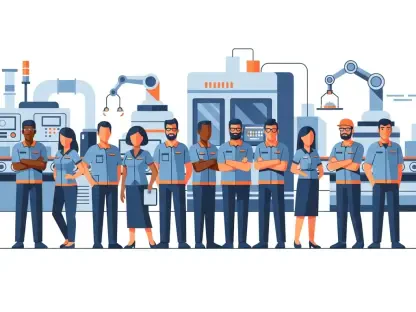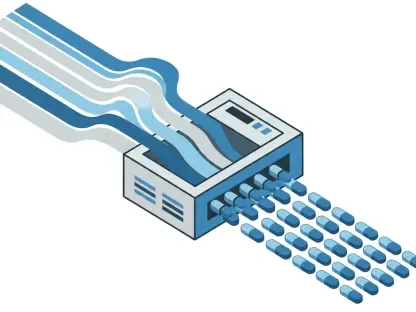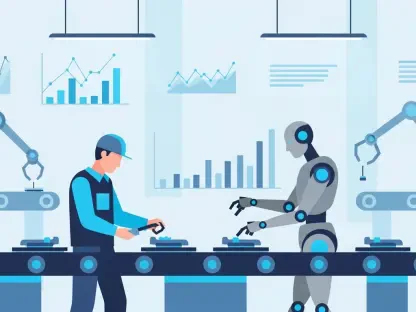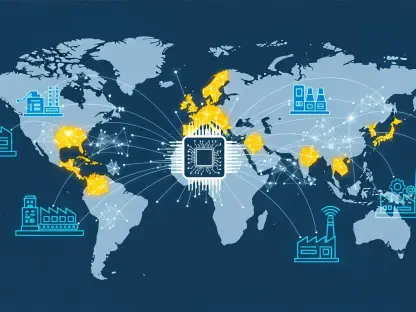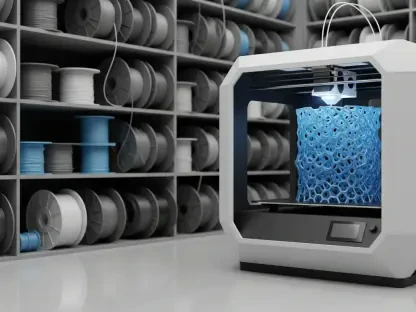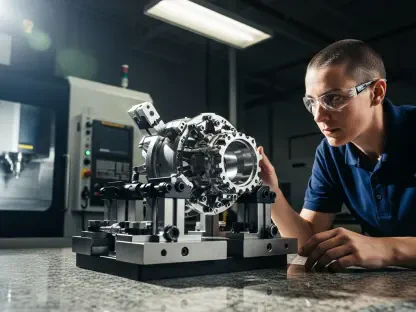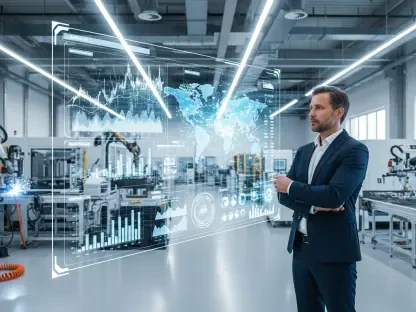In the midst of an unprecedented technological surge, the manufacturing sector stands at the brink of a historic transformation, rivaling the seismic shifts brought by Henry Ford’s assembly line over a century ago. Artificial Intelligence (AI) has emerged as the cornerstone of this revolution, converting conventional factories into intelligent, adaptive ecosystems capable of far more than mere production. The pressing need to address persistent issues like exorbitant downtime costs, workplace safety hazards, and operational inefficiencies drives this change. With AI, the industry pivots from prioritizing raw speed to embracing smart, data-informed decision-making. The economic stakes are immense, as downtime in sectors like automotive can cost up to $2.3 million per hour. This staggering figure underscores the urgency for innovative solutions, positioning AI as a lifeline for manufacturers. This exploration delves into how cutting-edge technologies are redefining factory operations, setting new benchmarks for efficiency and intelligence in an ever-evolving industrial landscape.
Harnessing Predictive Power for Uninterrupted Operations
The advent of predictive manufacturing intelligence marks a profound shift in how factories function, moving away from outdated, reactive approaches to a forward-thinking model. Traditional systems often wait for equipment breakdowns to occur, resulting in significant disruptions and financial losses that burden major companies with millions annually. In contrast, AI-driven systems, powered by agentic AI, leverage vast data streams to identify patterns and predict potential failures before they materialize. This proactive stance minimizes unplanned downtime, ensuring that production lines remain operational and efficient. The ability to foresee issues transforms the factory floor into a space of anticipation rather than reaction, fundamentally altering the approach to maintenance and resource management in manufacturing environments.
Beyond mere prediction, agentic AI operates as a relentless guardian of operational continuity, learning continuously from incoming data to refine its foresight. This technology not only anticipates mechanical wear but also optimizes production parameters in real-time to avert disruptions. Such capabilities translate into substantial cost savings, as preventing even a single hour of downtime can preserve millions in revenue. Furthermore, this intelligent oversight fosters a culture of reliability, where equipment performance is no longer a gamble but a calculated certainty. Manufacturers adopting these systems gain a competitive edge, establishing a new standard where efficiency and foresight are intertwined, paving the way for a more resilient industrial framework.
Simplifying Innovation Through Collaborative Technology
A remarkable stride in manufacturing technology comes with collaborative “vibe coding,” a method that strips away the complexity of traditional programming by enabling engineers to interact with systems using natural language. This innovation democratizes the development process, allowing even those without deep coding expertise to contribute valuable ideas and solutions. The result is a dramatic reduction in the time needed to create and implement new systems, empowering a broader range of professionals to drive innovation. By breaking down technical barriers, vibe coding ensures that creativity and problem-solving are no longer confined to a select few, thus enriching the manufacturing sector with diverse perspectives and accelerating technological advancement.
When integrated with agentic AI, vibe coding forms a powerful alliance between human ingenuity and machine efficiency, reshaping how solutions are crafted on the factory floor. Engineers can articulate specific needs—such as detecting potential equipment failures days in advance—and watch as AI autonomously generates, tests, and deploys tailored applications. This synergy slashes development timelines while producing sophisticated systems that traditional methods struggle to match. The adaptability fostered by this partnership enables factories to pivot quickly in response to shifting demands, ensuring that operational needs are met with precision and speed. This collaborative approach not only enhances innovation but also positions manufacturers to stay ahead in a rapidly changing industrial landscape.
Prioritizing Safety with Intelligent Monitoring
Safety continues to be a paramount concern within manufacturing, and AI is proving to be an indispensable ally in addressing this critical area. Advanced systems, built on the foundation of vibe coding and agentic AI, provide real-time monitoring of factory environments, detecting hazards such as pressure irregularities or chemical exposures with remarkable accuracy. These systems go beyond mere detection by offering immediate recommendations for corrective actions, ensuring compliance with stringent safety regulations while safeguarding workers. This proactive monitoring transforms the workplace into a secure haven, where potential risks are neutralized before they can escalate, reinforcing a commitment to employee well-being and operational integrity.
Adding to this safety revolution, digital twins—virtual replicas of physical assets—enable manufacturers to simulate and test operational changes without exposing real-world systems to risk. Paired with generative AI, these tools facilitate the creation of customized training programs that prepare employees for hazardous scenarios in a controlled, virtual setting. Such initiatives ensure that workers are equipped with the knowledge and skills to handle dangers effectively, minimizing accidents and fostering a culture of preparedness. By integrating real-time hazard detection with virtual safety training, AI technologies create a robust framework for risk management, building workplaces that are not only safer but also more resilient to the unpredictable challenges of industrial operations.
Fostering Unity Through Cross-Functional Integration
One of the longstanding challenges in manufacturing has been the presence of communication silos across departments, often leading to delays and inefficiencies. AI addresses this issue head-on by integrating data from production, logistics, and maintenance into a cohesive, unified system powered by agentic AI. This seamless connectivity ensures that critical information flows freely between teams, enabling instant responses to issues as they arise. For example, a defect identified during production can trigger immediate alerts to quality control and adjustments to logistics schedules, keeping all stakeholders aligned. Such integration eliminates bottlenecks, paving the way for smoother operations and a more synchronized approach to factory management.
Complementing this data unification, vibe coding offers the flexibility to adapt processes dynamically without the delays associated with conventional programming methods. Teams can tweak workflows in real-time, responding to operational hiccups with agility and precision. This capability enhances overall efficiency by ensuring that adjustments are implemented swiftly, maintaining the rhythm of production. As communication barriers dissolve, factories evolve into interconnected ecosystems where every department operates in harmony, driving collective success. The result is a manufacturing environment that thrives on collaboration, leveraging AI to bridge gaps and deliver outcomes that benefit the entire operation.
Navigating Ethical Challenges in AI Adoption
While the benefits of AI in manufacturing are undeniable, the ethical implications of its integration demand careful consideration. Unchecked AI systems risk compromising sensitive data, potentially leading to privacy breaches that undermine trust and operational security. Additionally, over-reliance on automation could diminish human expertise, reducing situational awareness in critical scenarios. To mitigate these concerns, robust data governance and rigorous testing protocols must be prioritized to validate AI outputs and ensure reliability. Balancing technological advancement with ethical responsibility is essential to harnessing AI’s potential without sacrificing integrity or safety in manufacturing processes.
Beyond technical safeguards, maintaining human oversight remains a cornerstone of responsible AI deployment in factories. Continuous training and fostering a culture of AI literacy among workers help preserve human judgment, particularly in high-stakes decisions where intuition and experience are invaluable. Manufacturers must invest in education initiatives to equip their teams with the skills needed to collaborate effectively with AI systems. By championing a balanced approach that integrates innovation with accountability, the industry can navigate the complexities of AI adoption. This commitment to ethical practices ensures that the transformative power of smart factories is realized in a manner that upholds both operational excellence and human-centric values.
Building a Future of Responsible Innovation
Reflecting on the journey of AI in manufacturing, it’s evident that the strides made through predictive intelligence, collaborative coding, and enhanced safety measures have profoundly reshaped the industrial landscape. Agentic AI and vibe coding redefined operational efficiency, turning reactive fixes into proactive prevention and saving millions in downtime costs. Digital twins and real-time monitoring fortified workplace safety, ensuring compliance and protecting lives. Cross-functional integration broke down barriers, fostering a collaborative spirit that elevated factory performance to new heights. These advancements laid a solid foundation for a smarter, more connected era of manufacturing.
Looking ahead, the path forward hinges on a commitment to responsible innovation. Manufacturers must continue to prioritize ethical frameworks, investing in workforce training to maintain a harmonious balance between human expertise and AI capabilities. Strengthening data governance and rigorous validation processes will be crucial to safeguarding privacy and reliability. By embracing adaptability and fostering continuous learning, the industry can build on past achievements to set even higher standards. The focus should remain on creating resilient ecosystems where technology and human insight coalesce, ensuring that the legacy of this transformation is one of sustainable progress and enduring excellence.


